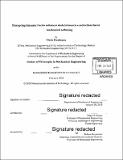Disrupting dynamic f-actin enhances skeletal muscle contraction due to mechanical softening
Author(s)
Sivathanu, Vivek
DownloadFull printable version (19.52Mb)
Other Contributors
Massachusetts Institute of Technology. Department of Mechanical Engineering.
Advisor
Roger D. Kamm.
Terms of use
Metadata
Show full item recordAbstract
Skeletal muscle wasting disorders such as sarcopenia affect the daily mobility of millions of aging people globally due to decreased muscle mass and decreased muscle efficiency. In this study we discover a novel target to improve the efficiency of skeletal muscle by targeting the dynamic f-actin cytoskeleton. Using two model systems, an ex-vivo mouse muscle model and a novel in vitro optogenetic skeletal muscle micro-tissue model, we show that disruption of the dynamic f-actin cytoskeleton using small molecule actin dynamics inhibitors leads to a persistent 2-fold improvement in muscle active contractility. We explored possible drawbacks of f-actin disruption, including loss of mechanical integrity, cell death, and intracellular organelle damage. None of these downsides actually present themselves with f-actin disruption. Muscle fatigue resistance however does seem to be slightly affected. We performed a detailed characterization of the cytoskeletal modifications that occur during f-actin disruption using dose-response-recovery studies, live f-actin imaging, fluorescence recovery after photobleaching and more targeted f-actin disruption. Using these studies we conclude that treatments which shorten f-actin filaments seem to improve contraction. We also uncovered previously unidentified roles of branched and tropomyosin stabilized f-actin in force transmission. Biomechanical testing at the cell level using AFM and at the tissue level using a micro-tensile test shows a drop in mechanical stiffness that correlates well with a corresponding improvement in muscle force. We ruled out a range of alternate hypotheses involving changes to sarcomeric proteins and energetic activity, that could explain the force improvement, concluding that the force improvement due to f-actin disruption is due to mechanical softening of the cells which pose to a lower resistance to their own contraction. As a potential application, we show that a weak 3D printed muscle powered biological robot starts walking with f-actin disruption. This target has significant therapeutic potential in muscle disorders due to its disease non-specificity. We conclude by discussing possible future experiments that could reveal the best therapeutic applications. Key words: Muscle strength, f-actin, cytoskeleton, Skeletal Muscle Tissue Engineering, Muscle Disorders.
Description
Thesis: Ph. D., Massachusetts Institute of Technology, Department of Mechanical Engineering, 2018. Cataloged from PDF version of thesis. Includes bibliographical references (pages 128-135).
Date issued
2018Department
Massachusetts Institute of Technology. Department of Mechanical EngineeringPublisher
Massachusetts Institute of Technology
Keywords
Mechanical Engineering.